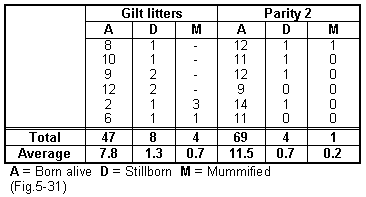



Low litter sizes
To study a problem of low numbers born alive look at the total born. Consider the following two scenarios of herds with problems. (Fig.5-30).
Herd A had a problem of embryo loss before day 35 of pregnancy. Herd B had a problem after day 35, evident from the levels of mummified pigs. An analysis of records identified a management/service problem in A and an infectious problem in B.

Examination of the farrowing records for the last 6 gilt and 2nd parity litters in herd B gave the following results. (Fig.5-31). The high numbers of stillbirths and mummies seen in the gilts is an indication of infectious disease - indicating probably parvovirus infection or PRRS. The problem relates to only gilts in this herd as evident by the good performance in parity 2. The solution was to vaccinate gilts with parvovirus vaccine after demonstrating disease in the mummified pigs by the fluorescent antibody test. Of course, in the field you should look at more than 6 litters, as this is a simplified example.
Key points to consider with a litter size problem

Sow effects
- Analyse at least 4 months of farrowing information.
- Analyse the results by born alive, dead, mummified, parity and boar used.
- Look at the distribution of good and poor litters. Is litter size generally depressed or are failures related to a few very poor litters?
- Is there anything common to those animals with poor litters?
- Determine if causes are infectious or non infectious.
- Check the breeding of the sows - do they express good hybrid vigour?
- Assess the effects of lactation length. On average 0.1 per pig is lost for each day lactation is reduced below 28 days.
- If there is a gilt problem assess the management as described previously in this chapter.
- Assess potential losses in groups 1 to 4.
- Assess key factors associated with poor fertilisation.
- Assess factors associated with normal repeats Fig.5-21 and abnormal repeats Fig.5-22.
- Check gilts are vaccinated against parvovirus.
Boar effects
- Young boars up to 9 months old produce smaller litters.
- Litter size differences exist between boars. Use records to identify.
- Check records. For each boar multiply the farrowing rate by the average total litter size. This gives a guide to numbers born per 100 services. A poor record would be 800, a good one more than 1000.
- Serve twice at 24 hour intervals.
- Always leave 24 hours between each completed boar mating.
- Check the general health of boars. Lameness or stiffness may result in poor litter size.
- Look at the timing and frequency of services. Fig.5-20. The time of mating relative to ovulation is important.
- There are no medicines that will increase libido or semen quality.
- Litter size is maximised by the time the boar is 15 - 20 months of age. This is worth up to 1.9 pigs per annum extra compared to younger boars.
- Farrowing rate is also maximised in this age of boar.
- Have sufficient boars for each to mate one sow per week.
Nutrition
- Feed the sow to appetite during lactation and to point of service with a high energy >14MJ DE/kg and >1% lysine.
- Feed gilts ad lib for 3 weeks prior to mating.
- Check the energy level of the diet relative to feed intake and to performance.
- Monitor body condition and fat depths.
- Avoid significant weight loss in the sow during lactation (>10kg).
Management and environmental effects
- Assess the dry sow house environment for draughts, wet pens, no bedding, hygiene etc. particularly from weaning to 21 days post-service.






